There are 23 Salamanders in Oklahoma including mole salamanders, sirens, newts, mudpuppies, and lungless salamanders. In total the state has 58 amphibians overall.
While most of the salamanders within the state are terrestrial, a few are aquatic. These include the central newt, the lesser siren, and the mudpuppy. All the rest are terrestrial or semi-terrestrial as adults.
Salamanders occur statewide. Some such as the grotto salamander live exclusively in caves and karsts as adults.
So what are salamanders? These are amphibians under the order Urodela. While most salamanders resemble lizards, they are indeed amphibians and not reptiles.
Table of Contents
Salamanders In Oklahoma
Family Ambystomatidae
Species under Ambystomatidae are commonly called mole salamanders.
1. Ringed Salamander

- Binomial Name: Ambystoma annulatum
- Total Length: 5.5 to 7 inches
- Record Length: 9 inches
The ringed salamander derives its common name from the yellow bands/rings that go around its upper body. These rings are yellow. The background color of the species is black. The yellow rings do not extend around the underside which is gray to yellow. The tail of the ringed salamander is round cross-section-wise.
Within Oklahoma, the species is endemic to the western portion of the state.
2. Spotted Salamander
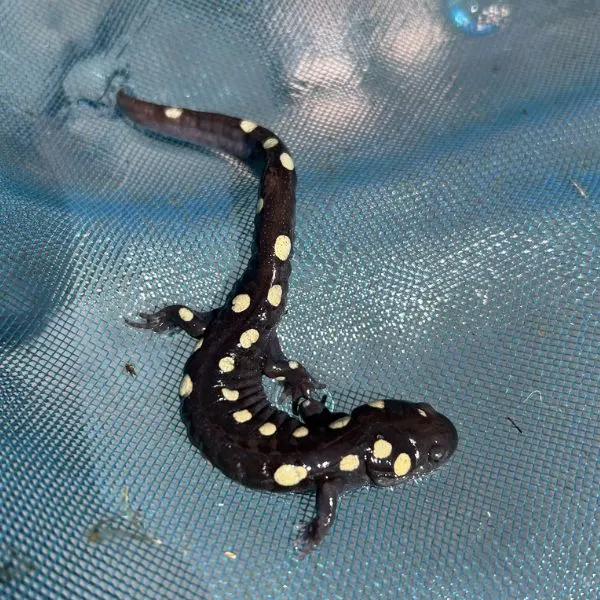
- Binomial Nomenclature: Ambystoma maculatum
- Total Length: 4 to 8 inches
- Record Length: 9 inches
The spotted salamander is a large and stout salamander. This salamander has a large head and eyes. It derives its common name from the spots on its back. These spots are highly visible as the species has black skin and the spots are yellow. The spots are on the head body and tail.
The underside of the species is white or light gray and has no patterns. The tail is keeled/laterally compressed and lacks a fin.
The species is endemic to North America and its range stretches from south-central Oklahoma to the rest of the eastern United States and from southern Canada all the way to Mississippi and Alabama.
3. Marbled Salamander
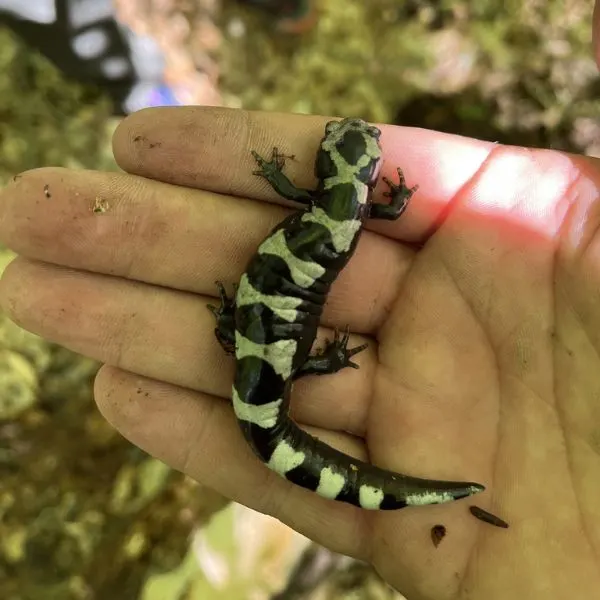
- Binomial Nomenclature: Ambystoma opacum
- Total Length: 3 to 4 inches
This is a small salamander with a chunky appearance. The skin is black with about 7 to 16 silvery-white and silvery-gray crossbands on its tail and back. Adult males have silvery white bands and adult females have silvery gray bands.
The species can grow to a body length of 3 or 4 inches.
Within Oklahoma, the species is endemic to Adair, McCurtain, Atoka, Pushmataha, Latimer, and LeFlore countries. All of these counties are in the southeastern regions of Oklahoma.
The species is endemic to humid wooded areas.
4. Mole Salamander
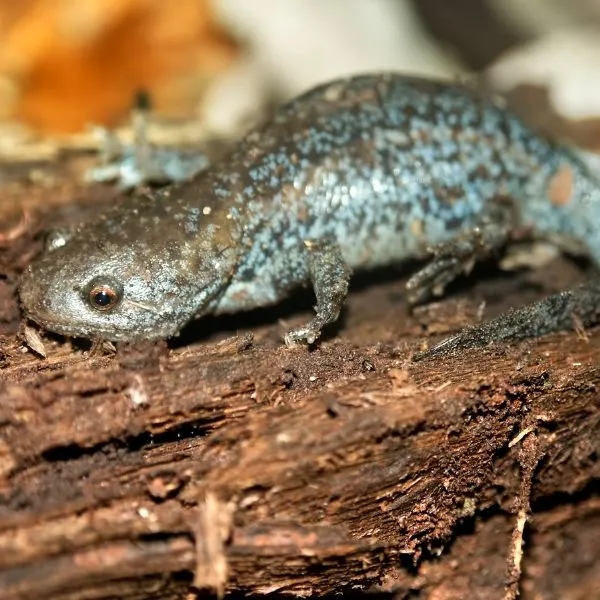
- Binomial Nomenclature: Ambystoma talpoideum
- Total Length: 4 inches
The mole salamander is a small and stocky amphibian with a large head and tiny legs. This salamander reaches a length of just 10 inches. The background color of the species is dark brown or gray. There are even darker mottling on the upper body and the belly is lighter in color.
The species is endemic to most of the southeastern lowlands of the Gulf Coastal Plains.
(sources: )
5. Small-Mouthed Salamander

- Binomial Nomenclature: Ambystoma texanum
- Total Length: 4 to 6 inches
- Record Length: 7 inches
The small-mouthed salamander derives its common name from its small mouth. The head of the species is also small and distinctively so. Apart from the head, the eyes are also small.
The species is dark in color with no distinct patterns. The skin color is greenish-black, dark blue, or black. The species have some fleckings on ht skin. The limbs are of a similar color as the back but are of a lighter shade.
Ambystoma texanum is a common salamander and live in wooded habitats such as woodlands. They also inhabit pastures. Similar to other mole salamanders, Ambystoma texanum is often underground in burrows.
The range of species ranges from central Texas and goes through western Tennessee, western Alabama, and Ohio. Northward, the range extends from Texas to southern Michigan.
Aquatic larvae feed on small aquatic invertebrates while terrestrial adults feed on earthworms and other invertebrates.
6. Barred Tiger Salamander

- Binomial Nomenclature: Ambystoma tigrinum
- Record Length: 11.5 inches
The barred tiger salamander is among the largest salamanders in North America. They are definitely one of the largest land salamanders in the world. The species get their common name from the black and yellow pattern of their skin. This pattern is yellow bars/bands on a black background. As such, their skin resembles that of a tiger.
The species is endemic to the western portion of Oklahoma. Outside Oklahoma, the species is endemic from south-central Canada to the rocky mountains in the united states. Their range extends as far as Chihuahua and Sonora in Mexico.
The species is terrestrial as adults but are always close to water bodies such as ponds, small lakes, streams, and other similar water bodies.
As with other mole salamanders, the tiger salamander spends most of its time hidden.
Family Plethodontidae
Members of Plethodontidae are lungless salamanders. These individuals respire through their skin and mouth.
7. Ouachita Dusky Salamander

- Binomial Nomenclature: Desmognathus brimleyorum
- Total Length: 7 inches (17.8 cm)
This is a lungless salamander as all duskies are. This salamander derives its name from Ouachita Mountain where it lives. Apart from the Petit Jean Mountain, this salamander is endemic to the following mountainous regions of Oklahoma and Arkansas – the Potato Hills north of Tuskahoma, the Kiamichi Mountains, the Black Fork Mountain Wilderness, the Black Fork Mountain Wilderness, Rich Mountain, and Petit Jean Mountain.
The species is endemic to mountainous streams, woodlands, and ravines, in gravelly areas, and near springs.
This salamander has a uniform coloration – grey or greenish brown.
8. Spotted Dusky Salamander
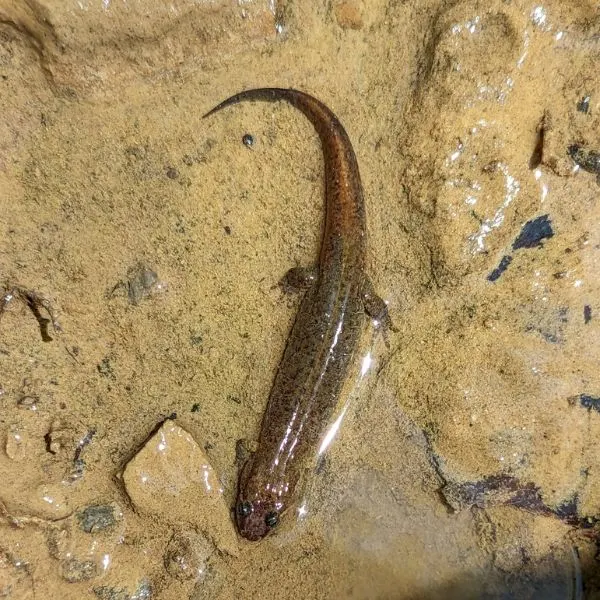
- Binomial Nomenclature: Desmognathus conanti
- Total Length: 2.5 to 5 inches
The species is endemic to the southeastern to south-central United States. This is a small salamander that is moderately stout. The tail is keeled. There are several yellow spots on the back. The underside is lighter in color. The species is known to fluoresce in the dark.
9. Longtail Salamander

- Binomial Nomenclature: Eurycea longicauda
- Total Length: 4 to 8 inches
The tail of this species is pretty long. On average the tail comprises up to 60 to 70 percent of its total body length. On average, the snout-to-vent length of the species is 2 inches and the tail is 2.8 inches.
The species inhabits cool and humid places such as the mouth of caves, ponds, spring runs, and streamsides. This species is often well hidden under logs, rocks, and in the crevices of rock surfaces.
The species is orange-red or red to yellow in color with black spots all over the head and back.
The species is endemic to the easternmost portion of Oklahoma.
10. Cave Salamander

- Binomial Nomenclature: Eurycea lucifuga
- Total Length: 4 to 6 inches
- Record Length: 7 inches
The cave salamander derives its name from one of its common habitats – caves. This salamander is small and slender with a very long tail. Its tail makes up about 60 percent of its body length.
The color of the upper body of this salamander is reddish. The coloration ranges from orange-yellow, and orange to red. The body is covered in black spots. The head is quite large although flatten. The belly of the species is of a similar color to the body but is of a lighter shade. The species has 13 or 14 costal grooves.
This species is similar in appearance to the dark-sided salamander although the dark-sided salamander has a longer tail with distinct black patterns.
The cave salamander is endemic to the Ozark Highlands including the Ozark foothills and Ozark Plateau in Oklahoma.
11. Many-ribbed Salamander

- Binomial Nomenclature: Eurycea multiplicata
- https://www.iucnredlist.org/species/59270/11908106
The many-ribbed salamander is endemic to eastern Oklahoma. It is also endemic to northwestern Arkansas, Cherokee County in Kansas, and southwestern Missouri. This salamander is endemic to caves karsts, springs, rivers, and forested habitats such as deciduous forests.
The species remain well-hidden under debris, logs, and rocks when in or out of water.
This tiny salamander is gray or yellow. The underside is also the same color but lighter.
12. Western Grotto Salamander
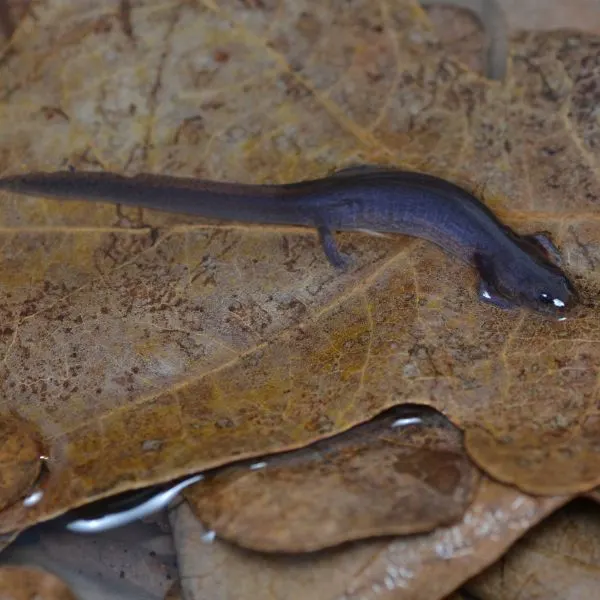
- Binomial Nomenclatures: Eurycea spelaea
- Total Length: 3 to 5.3 inches (7.5 to 13.5 cm)
- Lifespan: 12 years
- https://www.iucnredlist.org/species/22707/9379701
This species is also known as the Ozark blind salamander or the grotto salamander. It lives in caves, karsts, and springs. The species is mostly endemic to the Ozark Mountains, specifically the karsts underneath the West Springfield Plateau.
As the species live in darkness, they are blind. These are not surface-dwelling salamanders and you may never come across one. Interestingly, the species isn’t born blind. As larvae, they have functioning eyes. However, once they metamorphose into adults, their eyelids fuse shut and they become blind. This isn’t an issue as they now live exclusively in the darkness of caves.
The grotto salamander is white in color.
13. Oklahoma Salamander

- Binomial Nomenclature: Eurycea tynerensis
- Total Length: 4.1 inches (10.5 cm)
- Lifespan: 10 years
As you tell, the Oklahoma salamander is endemic to Oklahoma. This amphibian inhabits freshwater springs, rivers, and temperate forests such as deciduous and mixed forests.
Sometimes individuals of the species undergo metamorphosis. Sometimes they do not and remain neotenic even as adults.
The species is endemic to northeastern Oklahoma, specifically the Ozark Plateau. Outside of Oklahoma, the species is endemic to northern Arkansas, southeastern Kansas, and southeastern Missouri. Within all of these locations, the species is found in the Ozark Plateau.
14. Four-toed Salamander
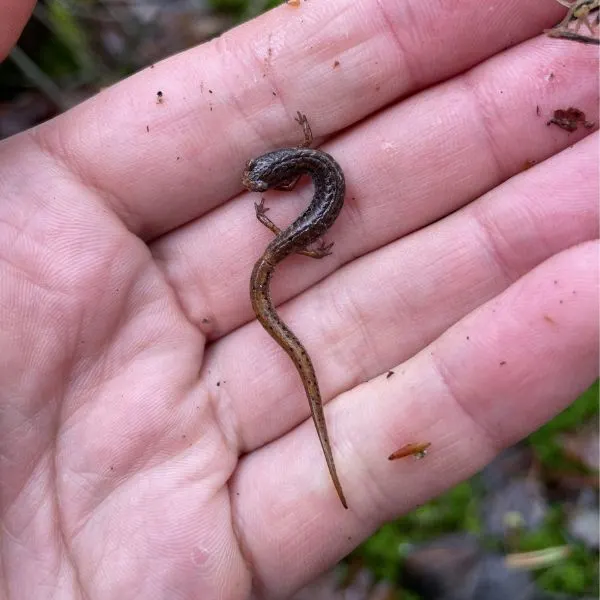
- Binomial nomenclature: Hemidactylium scutatum
- Total Length: 2 to 3.5 inches
- Lifespan: 5.5 years (female in captivity)
- https://www.iucnredlist.org/species/59285/193374453
The four toes salamander is lungless, just like all the other members of the family Plethodontidae. This salamander derives its common name from the four toes on both its front and hind limbs, unlike most salamanders that have five toes on their hind limbs. This species has a white underside which has a scattering of black spots. The upper body is brownish to reddish brown.
This species is endemic to mixed forests, deciduous forests, sphagnum bogs, and other grassy habitats. Most of the time the species remain hidden.
The species is endemic to southeastern Oklahoma.
15. Western Slimy Salamander

- Binomial Nomenclature: Plethodon albagula
- Total Length: 4 to 7 inches
- Record Length: 8 inches
- https://www.iucnredlist.org/species/59329/118993270
The slimy salamander derives its name from the sticky secretion it produces when stressed. This sticky secretion is difficult to wash off.
Plethodon albagula is medium-sized. It is also slender and has tiny legs. The tail is very long and can be up to 70% as long as its entire body. The head is slightly wider than the rest of its body. The species has a blueback to black background color with brassy/whitish starry spots on its body, head, and tail. The underside is black as well and has a few white patterns on there.
The species is endemic to the eastern portion of Oklahoma. It inhabits wooded areas.
16. Ozark Zigzag Salamander
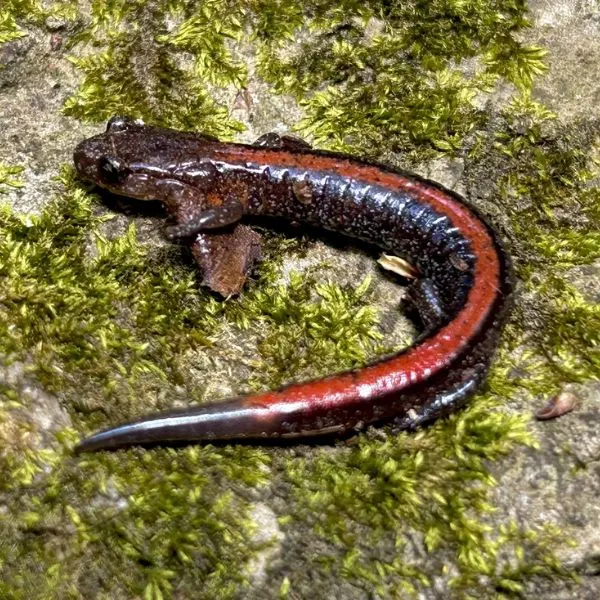
- Binomial Nomenclature: Plethodon angusticlavius
- Total Length: 2.3 to 4 inches
- https://www.iucnredlist.org/species/59331/194185218
The species is endemic to the Ozark region of eastern Oklahoma. This amphibian is also endemic to the Ozark region of northern Arkansas and southern Missouri. The species derives its common name from its geographic range as well as the red stripe on its back. This stripe has wavy or zigzag edges.
The species remain well hidden during the day. It hides under leaves, logs, and rocks. The species inhabit moist rocky crevices in ravines, wooded slopes, caves, seepages, rubble, and canyons.
17. Kiamichi Slimy Salamander

- Binomial Nomenclatures: Plethodon kiamichi
- Total Length: 2 to 3 inches
- https://www.iucnredlist.org/species/59345/118995197
The Kiamichi slimy salamander is endemic to the Round and Kiamichi Mountain range in southeastern Oklahoma. Within Oklahoma, the species is endemic to Pushmataha, Le Flore, and Atoka counties. In Arkansas, they are endemic to just Polk county.
The species is black in color with several white flecks. The whiles on the black background is reminiscent of stars in the night sky. The ventrum of the amphibian is gray.
The species is known as the slimy salamander because of the slimy liquid it secretes when handled.
18. Rich Mountain Salamander

- Binomial Nomenclature: Plethodon ouachitae
- Max Length: 2 inches
This salamander is endemic to the Ouachita Mountains specifically the Rich, and Black Fork Mountains, Rich, and Black Fork Mountains, Kiamichi Mountains, and Buffalo Mountains. It is endemic to Latimer County in Oklahoma.
The upper body of the species is maroon and black. There are several flecks on the upper body. The underside is dark.
19. Sequoyah Slimy Salamander

- Binomial Nomenclature: Plethodon sequoyah
The species’ geographic range is limited to Beavers Bend State Park, McCurtain County. This is the only place with confirmed sightings. The species may be endemic to Arkansas although records of the sighting are questionable.
Little is known of this slimy salamander. The species live in mixed forests and hardwood forests where it mostly inhabits ravines and moist woods. Similar to other salamanders, it usually remains well hidden under logs and rocks.
20. Southern Red-backed Salamander

- Binomial Nomenclature: Plethodon serratus
- Total Length: 3 to 4 inches (8 to 10.5 cm)
The red-backed salamander has a red stripe down its back which gives it its common name. There are individuals with no stripes. These are referred to as leadbacks. The leadback is a morph of the species.
The red stripe on their back has straight edges unlike that of the zigzag salamander which has wavy or zigzag edges.
Within Oklahoma, the species is endemic to the eastern portion of the state. The Oklahoma and Arkansas wild population of the species is endemic to the Ouachita Mountains.
Family Proteidae
Proteidae refers to mudpuppies and waterdogs. The only mudpuppy or water dog within the state is the Red River mudpuppy.
21. Red River Mudpuppy
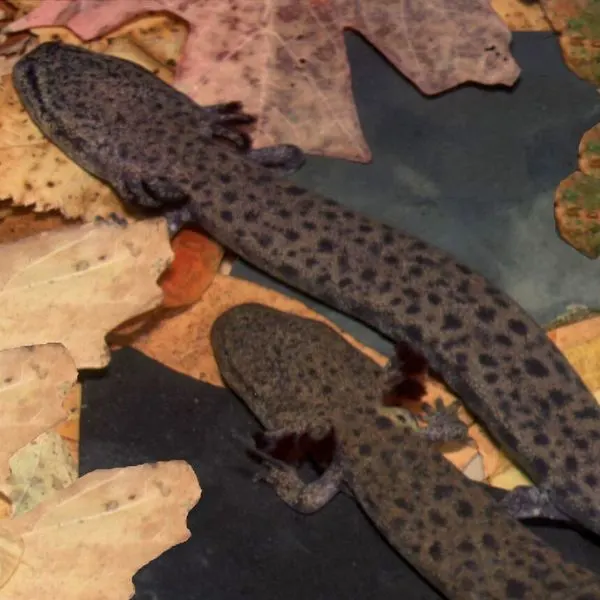
- Binomial Nomenclature: Necturus louisianensis
The species is endemic to eastern Oklahoma. The background color of the red river mudpuppy is light yellowish brown. There are dark botches and white stripes on this yellowish skin. A noticeable feature of the mudpuppy is the bushy red gills that stick out.
The red river mudpuppy is fully aquatic and requires a permanent body of water. They inhabit rivers and streams of the Red River and other waterbodies adjacent to it.
Family Salamandridae
Salamandridae includes newts such as the eastern and central newts. The only newt in the state is the central newt.
22. Central Newt
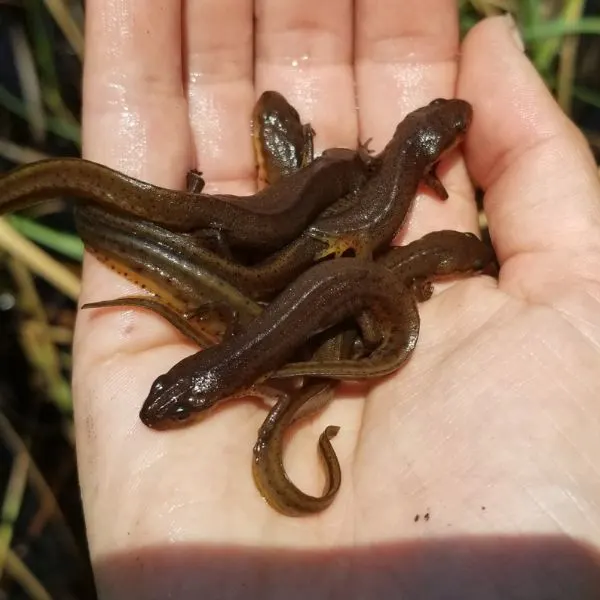
- Binomial Nomenclature: Notophthalmus viridescens louisianensis
- Total Adult Length: 2.5 to 4 inches
- Total Eft Length: 1.5 to 3.5 inches
- Record Length: 5 inches
The eastern newt is endemic to most of the eastern United States. This salamander is aquatic as an adult but has a terrestrial juvenile stage. During this terrestrial stage, it is referred to as an eft. As an eft, it is red to orange in color. As an adult newt, it is olive to yellow. There are specks on its upper body. As larvae, the newt is aquatic.
The eastern newt goes from aquatic to terrestrial and back to aquatic. There are individuals that never become efts and metamorphose directly from larvae to adults.
Family Sirenidae
Sirens are under the Family Sirenidae. The only siren in Oklahoma is the lesser siren.
23. Lesser Siren
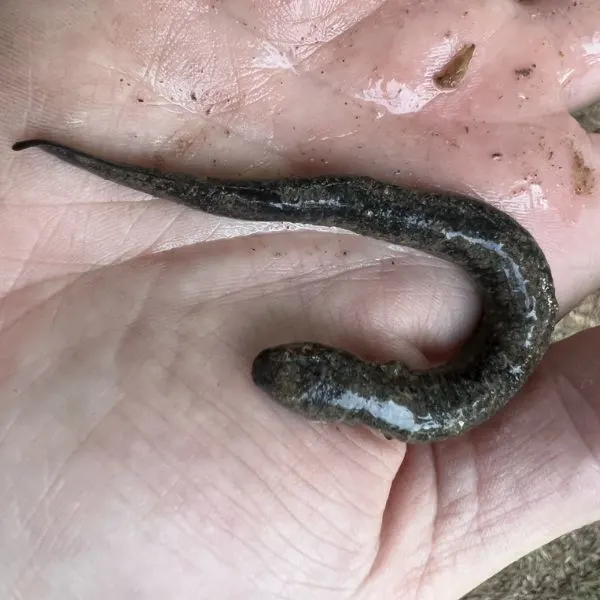
- Binomial Nomenclature: Siren intermedia
- Total Length: 10 to 19 inches
The species is endemic to most of the eastern United States and northern Mexico (northern Veracruz and northern Tamaulipas).
The species is also endemic to Oklahoma although the wild population within Oklahoma is limited.
Within Oklahoma, the species is endemic to only the southeasternmost corner.
The siren is a permanently aquatic amphibian. As a permanently aquatic amphibian, it has gills. The lesser siren is eel-like and has two front limbs that are extremely tiny and vestigial. Thes species lack hind limbs. The coloration of the species is black or dark gray, there are no other distinctive markings on it.
The species inhabits aquatic habitats such as flooded areas along streams, lakes, ponds, swamps, and even roadside ditches if aquatic vegetation is dense.
Frequently Asked Questions
What kind of salamanders live in Oklahoma?
There are about 22 different kinds of salamanders living in Oklahoma. Some of these include the red-backed salamander, the western grotto salamander, the mudpuppy, the lesser siren, and the central newt. While most of the salamanders in Oklahoma are lizard-like in appearance, the siren and the mudpuppy are eel-like.
Is a salamander a reptile?
Salamanders may resemble lizards but they are amphibians. This means that they are more closely related to frogs than they are to lizards. Not every salamander is lizard-like in appearance. The mudpuppy, hellbender, and siren do not resemble lizards. The siren is eel-like.
Is a salamander an amphibian?
Yes, salamanders are amphibians. They belong to the class Amphibia. Interestingly, some salamanders have gills, while others don’t. Salamanders with gills are larvae and permanently aquatic ones such as sirens. A large number of salamanders lack both gills and lungs but respire through their skin.
Are ringed salamanders poisonous?
Ringed salamanders are poisonous although the toxins they secrete aren’t potent enough to cause severe harm. They do taste horrible and deter predators.
Conclusion
There are about 23 salamanders in the state of Oklahoma. These include lungless salamanders, mudpuppies, newts, and mole salamanders.
The salamanders of Oklahoma live in forests, swamps, caves, streams, springs, lakes, and rivers. They are endemic to a wide variety of habitats. While salamanders are common, they can be difficult to spot as they remain hidden most of the time. Terrestrial salamanders in Oklahoma generally hide under rocks, logs, leaf litter, and underground burrows throughout most of the year.
While many of the salamanders of Oklahoma are terrestrial, a few are fully aquatic. The aquatic species include the mudpuppy, the central newt, and the lesser siren.
Other nearby states
